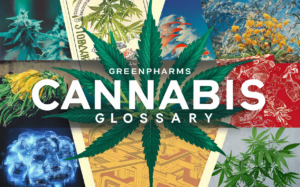Cannabis Glossary
Cannabis has formed a subculture and a lifestyle around it, complete with its own language. Our Cannabis Glossary can help you learn the lingo and sound like a pro!
A
Aeroponics – In cannabis cultivation, aeroponics is the manner by which cannabis is grown without being planted in soil. Instead, the plants are grown with their roots hanging freely, while water and nutrients are delivered directly to them.
Alcohol extraction – The method by which ethyl or isopropyl alcohol are used to extract hash oil. By the end of the process, the alcohol evaporates, leaving the concentrated cannabis with virtually no trace of alcohol.
Anthocyanin – Often affectionately referred to as “purps,” anthocyanin is a flavonoid credited with giving a plant its purplish hue.
B
BHO – Butane Hash Oil is a concentrated form of cannabis created through a process of extraction that uses a hydrocarbon (butane) as a solvent that is ultimately purged from the final product.
Bubble Hash – Bubble hash is a potent form of cannabis concentrate that is created through a solventless extraction process in which flower is washed in an ice bath before being agitated and processed through a series “bubble bags.” The product further separates from negligible plant matter and becomes more refined as it passes through each subsequent bag.
Bud – Also known as flower, this is a part of the plant that contains cannabinoids and terpenes with which the human endocannabinoid system interacts, resulting in psychoactive effects.
C
Caryophyllene – Unique among terpenes, caryophyllene can bond to C2 receptors in the endocannabinoid system without the need of an accompanying cannabinoid. Caryophyllene is a distinct terpene with particularly peppery characteristics.
Cannabinoids – Present in every cannabis plant, cannabinoids are compounds that produce or otherwise facilitate the familiar psychoactive properties usually associated with being “high.”
Cold Start – A method by which a dab is placed in a quartz banger before external heat is applied, allowing the user to heat the concentrate to a desirable level without surpassing that temperature.
Cones – Cones are rolled papers, often sold empty or pre-packed with flower. Cones are particularly popular with consumers who find rolling their own joints challenging, as well as people who just prefer the convenience of being able to light up with minimal effort.
Couch Lock—This term refers to a particularly subduing effect that cannabis—typically indica—produces when consumed. An indica high is often referred to as a “body high,” which can cause the user to feel as if they are “locked” to the couch.
D
Decarboxylation – The process by which the psychoactive properties in marijuana are activated. Decarboxylation occurs when cannabis flower is exposed to a particular level of heat. When you smoke or vaporize marijuana, the decarboxylated flower is inhaled directly, whereas the process for making edibles can require plant matter to be exposed to temperatures between 210-245 degrees Fahrenheit for periods of approximately 40 minutes.
Distillate –
E
E-nail – A heating tool used in dabbing as an alternative to a blowtorch. In contrast to torches, which are fueled by butane, e-nails operate by the heating of a coil that attaches to the banger, making it possible for the user to easily reach a pre-determined temperature for a thorough, consistent hit.
Endocannabinoid System – A receptive system in the human body, the Endocannabinoid System (ECS) is equipped with CB1 and CB2 receptors that process cannabinoids and other components to create the familiar psychoactive effects associated with marijuana use.
Entourage Effect – A term used to refer to the full-spectral benefits of consuming cannabis flower as a whole. While THC is clearly the cannabinoid most popular among marijuana users, a growing consensus among the scientific community seems to indicate that other cannabinoids, terpenes and flavonoids not only bolster THC’s effectiveness, but possess their own health benefits when consumed with THC. In short, that particularly enjoyable “high” you encounter may not result solely from THC; it’s likely the result of THC interacting with CBD and other compounds that is
F
Flavonoids – Flavonoids are compounds that are present in cannabis. Studies conducted on the effects of some flavonoids appear to indicate promising implications with regard to its anti-inflammatory, anti-viral and chemo preventative properties, to name a few. From cancer and eczema to asthma and heart disease, research is ongoing to determine the degree to which flavonoids may be effective in medicine.
G
Genotype – The easiest way to understand the genotype of the plant is to think of it as a genetic code that lays out a range of possible ways in which the plant will grow. The physical manifestations of these possibilities are referred to as phenotypes. Every cannabis seed has its own unique genotype, not completely dissimilar from the way humans each have their own set of genes and DNA that is exclusive to each person.
Gram – a weight measurement commonly used in the sale of cannabis flower and concentrate.
H
Hybrid – A type of cannabis strain that is created by combining two different strains. Hybrids contain varying amounts of sativa and indica, allowing users to more closely tailor their consumption according to their particular preferences.
Hydroponic – A method by which cannabis is cultivated through the submersion in water as opposed to immersion in soil. This method is preferred by proponents who suggest that it is possible to send necessary nutrients directly to the roots of a plant.
I
Indica – A phenotype of cannabis that is characterized by a stout, bushy plant that produces short, wide leaves, which often display a purple tint. Indica plants are known for producing “body high” effects, as opposed to the comparatively “heady” effects of consuming sativa. Indica usually enters the flowering stage more quickly than its sativa relative, often producing buds within 45-60 days.
Inhaler – A product used to deliver medicine into the lungs, typically through the use of a mild dispatch of aerosol. Currently, there are inhalers on the market that contain both THC and CBD, which are available in varying degrees of dosage and potency.
Isolate – A cannabinoid or other cannabis compound that has been isolated from the rest of the plant. CBD isolate is a common example as it is often stripped from other elements in the plant that produce psychoactive effects.
J
Joint – A colloquial term for a marijuana cigarette. Joints can be rolled by the consumer, or purchased in pre-rolled form. Joints can be prepared by hand rolling or machine, as well as being packed into a cone.
K
Kush – This term can be used to reference particular strains of cannabis, or more generally as a generic descriptor for marijuana. Ultimately, the term is derived from the Hindu Kush Mountains from which a number of popular indica strains were originally grown.
L
Life cycle – This term refers to the stages in the life of a plant. There are two main stages in a plant’s life cycle; the vegetative stage, during which the plant is solely growing, and the flowering stage, where the plant prioritizes its energy allocation to the production of flower.
M
Marijuana – Often used interchangeably with the word cannabis, this term refers to the flower-producing plant with which consumers medicate. Cannabis emerged as the commonly accepted nomenclature over marijuana, largely due to the latter being used as a slang term in the early 20th century. As such, the term was largely used to disparage cannabis users (in particular, Latinx and Hispanic users) through biased, unfounded propaganda and yellow journalism. Anti-marijuana campaigns ultimately proved successful in forming negative public opinion, and cannabis was prohibited in the United States in 1937.
Mycotoxin – A group of metabolites, which, in certain amounts, can be harmful to humans. Mycotoxins can be found growing among a variety of plant life. In most legal states, cannabis is required to be tested for mycotoxins among other elements.
N
Nectar Collector – A popular tool among dabbers, a nectar collector is a versatile way to consume concentrates. Using a nectar collector is fairly simple—one end is heated and placed into close contact with cannabis concentrate, and the resulting vapor can then be sucked through the other end. There is usually a silicone or other heat resistant material between the two ends of the apparatus, limiting the amount of heat present on the end with which a user’s mouth can safely interact.
Nug – A slang term for the flower or bud derived from a cannabis plant.
Nug Run – Nug run refers to the plant material being used in a given extraction process. Whereas other types of methods, including trim run, utilize various other parts of the plant, nug run indicates only the use of only flower, which contains the most concentrated presence of cannabinoids.
O
Ounce – Along with the gram, an ounce is a unit of measurement commonly used in the packaging, distribution and sale of cannabis. In the State of Arizona, it is legal for individuals over the age of 21 to possess 2.5 ounces (70.83g) of cannabis for medical patients, and 1 ounce (28g) of cannabis for recreational consumers.
Outdoor – Refers to the method(s) of growing cannabis in an outdoor environment. This cultivation method is often heralded as a comparatively more environmentally friendly way of growing than indoor due to the fact that the former can utilize natural renewable resources such as natural sunlight, living soil and, in some cases, naturally occurring watering or irrigation infrastructure
P
Parts per million – In the context of cannabis, parts per million (PPM) most often refers to the levels of hydrocarbon solvents, such as butane or propane, present in cannabis concentrate following the extraction process, as determined through testing.
Phenotype – Put simply, phenotypes of a given plant refer to what it “grows up” to be. That is, whereas the genotype of a plant represents a sort of blueprint for how the plant will grow, the phenotypes are the actualization of that growth. Phenotypes refer to characteristics particular to each plant in terms of its genetic and molecular composition.
Propane Hash Oil (PHO) – Similar to BHO, propane hash oil is a cannabis concentrate that is created through a hydrocarbon extraction process. Propane is used to collect cannabinoids and terpenes before eventually, being purged.
Q
Quercetin – A flavonoid found in cannabis that is believed to possess anti-inflammatory properties that could be effective in a range of treatments, from reducing swelling to potentially killing cancer cells.
R
Rick Simpson Oil – Rick Simpson Oil, also commonly referred to as RSO, is a concentrated form of cannabis oil. RSO is named for its creator, Canadian cannabis activist Rick Simpson, who created the oil after being diagnosed with basal cell carcinoma, a form of skin cancer.
Rosin – A concentrate extracted from the resin-packed trichomes that form on the leaves and flower of a cannabis plant. Rosin is formed through the application of heat and pressure, resulting in a golden, syrup-like concentrate.
S
Salve – Cannabis and cannabinoid salves are most often used as a form of pain relief, but can be also be used to treat a variety of other ailments. The amount of a particular cannabinoid varies from product to product.
Sativa – A classification of cannabis that is characterized by notably longer, narrower leaves than that of its indica counterpart. While sativa plants typically grow larger than indica, they can also take longer to flower, with the typical flowering stage beginning after approximately 60-90 days. Sativa can skew toward more light and airy buds than indica due to both intrinsic growing habits and external environments.
Syringe – A number of extracts, from RSO to various forms of distillate, are available in syringe form, allowing consumers to press out the desired amount. Syringes can be used to deliver dosage into capsules, onto food, or directly onto a user’s tongue.
Solvent – A liquid that is used to breakdown solid plant matter, making it possible to separate and extract cannabinoids and terpenes.
T
Terpene – Found in all plant life, terpenes are plant compounds that give a plant its aromatic and flavorful characteristics, and may also provide individual health benefits that vary from one another.
Tincture – Tinctures are used to store cannabinoid oils. While there is a diverse array of prepackaged cannabinoid tinctures widely available, some consumers elect to create their own.
Trichome – A key part of the psychoactive makeup of a cannabis plant. Trichomes
U
Ultra Violet Light – UV or ultra-violet lighting is used in various cultivation methods and throughout various stages of a plant’s life. While some techniques, such as UVC treatments, are often used to deter the growth of mold, mildew and other mycotoxins, it’s important to note that such treatments can also degrade a plant’s potency by diminishing the levels of THC present in trichomes.
V
Vaping/Vaporization – Methods by which cannabis can be consumed, typically without the need for the flower to be combusted—a benefit allowing consumers to avoid harmful carcinogens released when smoke from ignited cannabis is inhaled.
W
Winterization – A method of extraction in which plant matter is frozen using subzero temperatures as a means of stripping away impurities and negligible fatty lipids and waxes to create an aesthetically pleasing final product.
X
Xanthophylls – Similar in some ways to flavonoids like anthocyanin, which create a purple hue, xanthophyll is a carotenoid responsible for the yellow pigments in a cannabis plant. However, xanthophyll is more than just a pigment; it also helps regulate the heat and light intake of the plant, and is perhaps most noticeable in chlorophyll-deficient plants, where its prominent yellows become increasingly visible.
Y
Yield – Sometimes used interchangeably with the term “harvest,” yield refers to the amount of cannabis that is collected during the harvesting process. Yield is likely to vary from plant to plant, but there are some constants, such as the difference in yield between sativa plants, whose stalks grow high and large, and indica plants, which tend to be smaller and thus result in comparatively smaller yields.
Z
Zip – Short for Ziplock, a “zip” is a proprietary eponym used to describe to an ounce of cannabis, weighed out and packaged in a resealable bag not unlike the household product of the same name.
Thanks for taking the time to check out the Cannabis Glossary. We hope you’ve learned a thing or two about cannabis culture and the cannabis community at large.
Cannabis glossary created by M Reveles, 05/2022
GreenPharms is more than just a dispensary. We are a family-owned and operated company that cultivates, processes, and sells high-quality cannabis products in Arizona. Whether you are looking for medical or recreational marijuana, we have something for everyone. From flower, edibles, concentrates, and topicals, to accessories, apparel, and education, we offer a wide range of marijuana strains, products and services to suit your needs and preferences. Our friendly and knowledgeable staff are always ready to assist you and answer any questions you may have. Visit our dispensaries in Mesa and Flagstaff, or shop online and get your order delivered to your door. At GreenPharms, we are cultivating a different kind of care.





